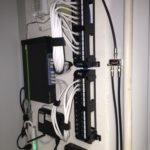Category 6 and Cat 6 Wiring
Category 6 is rated handle up to 10 Gigabit Ethernet at 250 MHz. This measurement is used to determine how much data the cable can move or its bandwidth capabilities. Category 6 cabling reduces crosstalk when compared to Cat 5e cabling due to its improved design. Crosstalk occurs when signals are transferred over to another circuit or channel and cause interference in the flow of data causing broken data streams and a reduction in network traffic.
Previously, telephone wiring used a pair of wires, Cat 6 wiring and cable uses 4 pair of wires in a single cable. These 8 wires allow data to be processed and sent through the network at very fast speeds. Cat 6 wiring is needed when new computers or printers are added to the office. Cat 6 wiring and installation can be performed at your office or within your building. Cat 6 cables are limited to 164 ft when supplying 10 Gigabit speeds., including patch cables. After that distance, its ultimate speed is the same as cat 5e, i.e. 1 Gigabit. Cat 5e cables are usually 24 gauge twisted pair wires, which can produce a Gigibit network at distances up to 328 ft., including patch cables at both ends.
According to www.serverackandcable.com, the faster the speed and better the quality of cable and installation, the more data can flow from each device to the Internet. Bandwidth and the rate of data transfer are related to each other in the same way as a highway is related to traffic. Increasing the data transfer rate is similar to increasing the quantity of lanes on a thoroughfare to increase the traffic flow. It has been observed that the data rates increase by 100% every eighteen months and due to this there is a need to use new means of transmission with better transfer rates. Today the apps moving at a transfer rate of 1 Gb/sec are hitting the ceiling of category 5e cables capabilities. Applications which require streaming of data like video and multimedia transfer demand high transfer rates and this demand can only be fulfilled by Cat 6 wiring and cables, which offer higher bandwidth. Use of Cat 6 will also boost the development of new applications which work with higher bandwidth.
If your office doesn't require fast data transfer, Category 5e is a very good choice. Network jacks, cabling, patch panels, patch cords and other equipment used with Cat 5e cabling are less expensive when compared to Category 6 cabling. The termination of Cat 6 wiring takes longer and the testing is more strict. If you upgrade your network switch to Gigabit speeds, you may want to consider installing Cat 6 wiring to allow the data to move as fast as the switch will process it. Hardware companies continue to introduce new equipment to the market that is faster and faster. Consider your use now and years down the road when installing your network cabling.
Category 6 cabling will provide a faster network speed when compared to Cat 5e. Category 6 cabling is a perfect choice when installing wireless access points or wireless routers. A streaming signal will benefit from the larger cable used to make Cat 6 cabling. The thicker the wire, the smaller the gauge. Cat 6 uses a larger copper wire to achieve the faster network speeds. Manufacturers may vary, but on average you will find that Category 5e cable is 24 gauge and Category 6 cable is 23 gauge.

